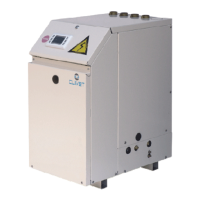Do you have a question about the CLIVET WSHN-EE 31 and is the answer not in the manual?
Label details, location, and importance for unit identification.
Importance of the serial number for unique identification and ordering spare parts.
Explains the summer and winter cooling cycles of the refrigerant.
Lists common reasons for the unit shutting down due to operational issues.
Unit's designed purpose and additional safety measures.
Identifies danger zones, handling risks, and necessary precautions.
Risks associated with incorrect installation and general operational hazards.
Details risks of improper electrical connections, grounding, and components.
Product details, supplier info, and hazard identification.
First aid, fire fighting, and protection measures for refrigerant handling.
Personal protection, chemical-physical properties, and stability.
Recommendations for storing and safely handling the unit.
Measures to prevent freezing and prepare the system, including filters and flow switches.
Guidelines for electrical installations, personnel, and wiring.
Technical electrical data tables for unit sizes and power supplies.
Step-by-step instructions for connecting the unit to the mains power.
How the 3-way valve manages sanitary hot water production.
Essential checks before performing the start-up procedure.
Verifying refrigerant circuit, water system, and electrical connections.
Mandatory pre-heating for crankcase heaters before compressor start.
Functions to protect compressors and optimize energy efficiency via set point adjustments.
Explains alarms, LEDs, and lists Electrical, Refrigerant, Water circuit alarms.
List of parameters accessible from the remote or service keyboard.
How to display statuses and general alarm information.
Detailed list of alarm codes (E, C) and their causes.
Procedures for visualizing and resetting alarms using the keypad.
Tables of pressure (Pg) vs. temperature for refrigerants.
Causes and troubleshooting for high/low pressure alarms in cooling.
Steps to identify and fix faulty probes and pressure transducers.
Causes and troubleshooting for compressor and pump protection alarms.
Causes and troubleshooting for high/low pressure alarms in heating.
Label details, location, and importance for unit identification.
Importance of the serial number for unique identification and ordering spare parts.
Explains the summer and winter cooling cycles of the refrigerant.
Lists common reasons for the unit shutting down due to operational issues.
Unit's designed purpose and additional safety measures.
Identifies danger zones, handling risks, and necessary precautions.
Risks associated with incorrect installation and general operational hazards.
Details risks of improper electrical connections, grounding, and components.
Product details, supplier info, and hazard identification.
First aid, fire fighting, and protection measures for refrigerant handling.
Personal protection, chemical-physical properties, and stability.
Recommendations for storing and safely handling the unit.
Measures to prevent freezing and prepare the system, including filters and flow switches.
Guidelines for electrical installations, personnel, and wiring.
Technical electrical data tables for unit sizes and power supplies.
Step-by-step instructions for connecting the unit to the mains power.
How the 3-way valve manages sanitary hot water production.
Essential checks before performing the start-up procedure.
Verifying refrigerant circuit, water system, and electrical connections.
Mandatory pre-heating for crankcase heaters before compressor start.
Functions to protect compressors and optimize energy efficiency via set point adjustments.
Explains alarms, LEDs, and lists Electrical, Refrigerant, Water circuit alarms.
List of parameters accessible from the remote or service keyboard.
How to display statuses and general alarm information.
Detailed list of alarm codes (E, C) and their causes.
Procedures for visualizing and resetting alarms using the keypad.
Tables of pressure (Pg) vs. temperature for refrigerants.
Causes and troubleshooting for high/low pressure alarms in cooling.
Steps to identify and fix faulty probes and pressure transducers.
Causes and troubleshooting for compressor and pump protection alarms.
Causes and troubleshooting for high/low pressure alarms in heating.











